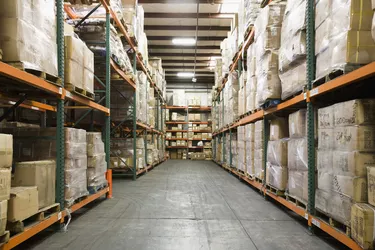
Keeping track of inventory levels helps you know more than just what you've sold in a particular period. Inventory management is a key tool for business planning because it can help you avoid disruptions to your sales, lost orders, decreased customer satisfaction and defections and poor online reviews.
Inventory changes also get recorded on specific financial reports, explains the Corporate Finance Institute, making this calculation necessary for accurate accounting. If you own stock in a company, looking at its change in inventory can help add to your knowledge of the company's recent performance.
Video of the Day
Video of the Day
Read More: Uses of an Annual Report
What is Inventory?
Inventory typically refers to the amount of finished physical products a company has on hand for sale. For accounting purposes, however, raw materials necessary for making finished goods, as well as partially completed products, are also included in inventory calculations, according to Intuit QuickBooks.
Service businesses, or businesses like restaurants, can benefit from knowing how many orders they can fulfill at any time based on the number of people and materials they have on hand. For example, a restaurant doesn't keep an inventory of pepperoni pizzas on hand. However, if pepperoni pizzas are the number one item it sells, keeping track of that pie's ingredients will make sure the restaurant doesn't run out of them.
If you're looking at a publicly traded company's performance, you will want to look at their financial statements for their inventory change on their income statement.
Pick Your Period
Businesses usually calculate changes in inventory over specific periods. A company might want to know its inventory levels on a monthly basis to make sure it has enough in-stock based on expected sales. A business might want to keep track of its inventory levels quarterly to help plan its raw materials purchasing and labor and production scheduling. Annual inventory calculations help with year-end budget reviews and tax preparation.
Read More: How to Calculate Raw Material Inventory Turnover
Making the Calculation
The easiest way to calculate a change in finished inventory is to pick a time period (usually one month, one quarter or one year) and subtract the inventory amount on your end date from the inventory amount on your first date. You will need to define "inventory" – are you talking about finished units, or materials, finished units and units in progress?
For example, if you are just tracking finished units available for sale, let's say you started the second quarter on April 1 with 100,000 units and ended with 80,000 units. Your change in inventory is 20,000, or -20 percent.
This number might not be very helpful, however. How many units did you make during the second quarter and how many did you sell? You might have sold 120,000 units, which required you to make 20,000 more units during that 90-day period. However, you have 80,000 units left over, so you now know you made 100,000 units, possibly many more than you needed. On the other hand, if most of your sales come at the beginning of a specific quarter, you now know that you only have 80,000 units to satisfy demand starting the next quarter.
How does your inventory change affect your finances? The accounting formula for calculating a change in inventory looks at your inventory values, explains AccountingTools.com. This will tell you how much you earned and spent making and selling inventory.
This inventory change formula is: Purchases + Inventory decrease - Inventory increase = Cost of goods sold. This type of inventory recording takes into account your raw materials and partially finished goods, in addition to your finished products (units ready for sale).
Let's say you started the second quarter with $200,000 worth of finished inventory and spent another $75,000 making additional inventory. You might consider that your inventory is now worth $275,000. However, if you made $75,000 worth of inventory that you can sell for $150,000, you might calculate your total inventory with a value of $200,000 + $150,000, or $350,000 worth of inventory.
This is why it's important to decide what your goals are for calculating your inventory. For example, are you going to include raw materials and partially finished products in your inventory figure? You would do that for accounting purposes, but not for inventory stocking purposes.
If your sales manager is asking for your change in inventory, you'll give a different answer than if your accountant or tax preparer asks for your change in inventory.